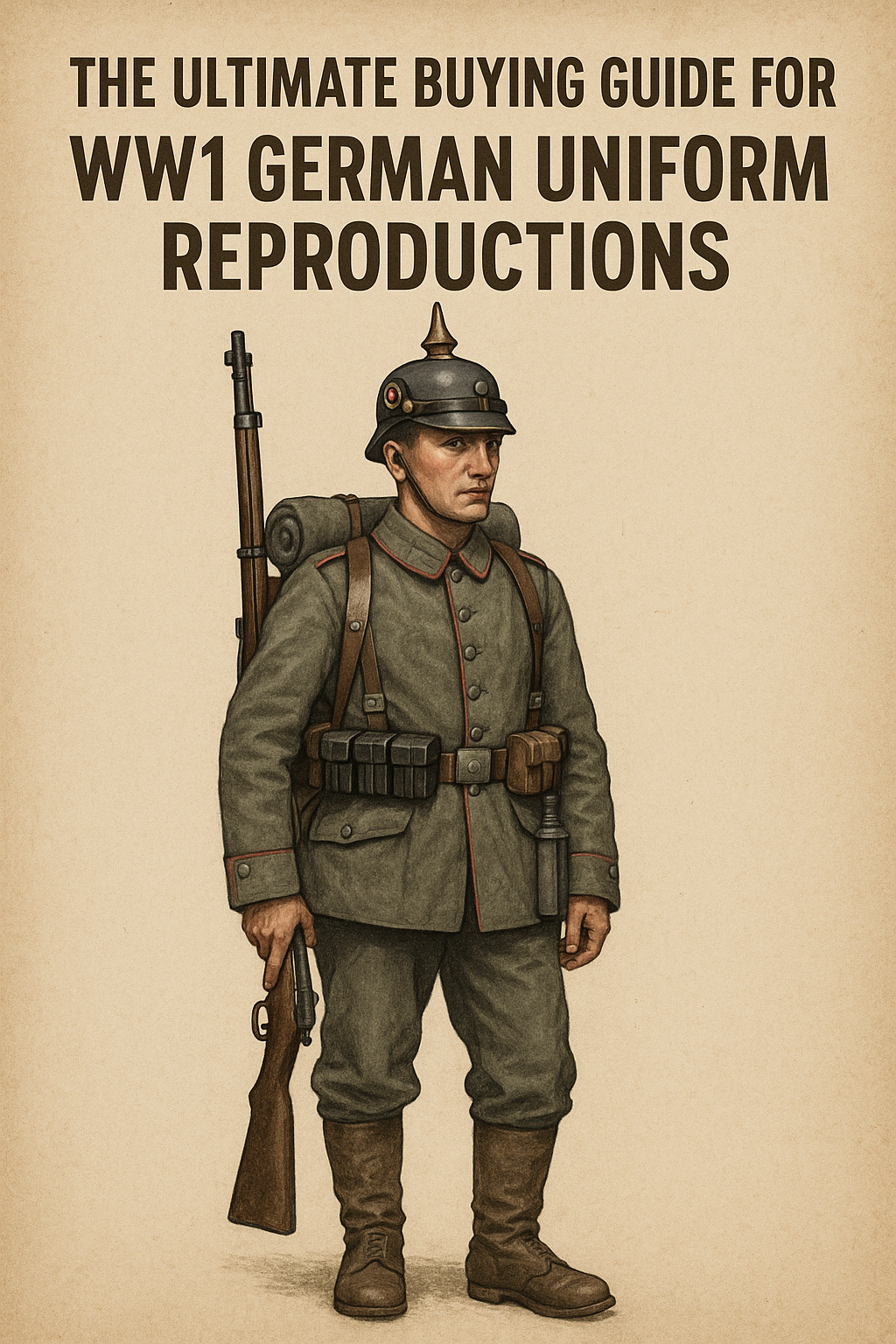
"The Ultimate Buying Guide for WW1 German Uniform Reproductions"
Published on Apr 19, 2025
Introduction
German military uniforms from World War I are a staple in historical collections and reenactments. Their design, color, and symbolism reflect a pivotal era in military history. Whether you're preparing for a reenactment, building a museum-quality collection, or simply passionate about military history, owning an accurate WW1 German uniform is a significant step. This guide will help you make an informed purchase and understand what truly makes a reproduction authentic.
What Were German Uniforms Like in World War 1?
Before diving into purchasing, it’s essential to understand what made WW1 German uniforms unique. These weren’t just clothing – they were symbols of a powerful military tradition and had to be both functional and intimidating.
1. The Pickelhaube (Spiked Helmet)
Easily one of the most iconic items of WW1 German military attire, the Pickelhaube was a leather helmet with a brass or metal spike on top. It served more ceremonial purposes by the mid-war years but remained a defining part of early German military dress.
2. Feldgrau Tunic (Field Grey Uniform)
The introduction of the feldgrau (field grey) uniform in 1910 represented a move toward more practical military wear. The grey-green tone provided better camouflage and became standard issue for the German Army. The cut of the tunic varied slightly depending on the soldier's rank, regiment, and time of service during the war.
3. Trousers and Footwear
Matching feldgrau trousers, often with red or piping details, were standard. Soldiers wore tall leather jackboots that were both rugged and durable — essential for trench warfare. Officers may have worn riding boots or breeches, especially cavalry units.
4. Insignia and Regiment Details
Shoulder boards, collar tabs, and buttons often displayed the soldier's regiment, rank, and sometimes even specific battalion. These details are essential when choosing a reproduction to ensure it matches the historical record.
Why Authenticity Matters
Whether you're reenacting or collecting, authenticity is key. A well-made uniform not only looks impressive but also respects the historical accuracy and integrity of the time period. Uniforms that are true to the original designs reflect your dedication and passion for history.
Authentic reproductions often use traditional manufacturing techniques and materials like wool, natural dyes, and hand-sewn details. The insignia placement, stitching, and fabric texture can make or break the authenticity of your gear.
How to Choose a Quality Reproduction
Choosing a reproduction isn’t just about what looks good — it’s about historical accuracy, comfort, and long-term value. Here’s what to look for:
1. Choose Reputable Suppliers
Stick with specialists who focus on historical military uniforms. Their attention to detail and access to original patterns or references usually produce the most accurate gear.
2. Inspect the Materials
The best reproductions use high-quality wool, linen linings, genuine leather, and metal fittings. Avoid polyester blends or plastic buttons — they detract from both the look and feel.
3. Look at the Stitching and Construction
Authentic WW1 uniforms had hand or machine stitching depending on rank and period. Double-stitching, reinforced elbows, and correct button spacing are all signs of attention to detail.
4. Pay Attention to Insignia and Piping
Whether it’s an infantryman’s red piping or an officer’s metallic thread, these details matter. Ensure that the collar tabs, cuffs, and shoulder boards are aligned with the regiment or unit you're trying to portray.
5. Consider Your Purpose
If you’re reenacting, comfort and durability matter just as much as authenticity. If you’re collecting, historical accuracy takes top priority. Know your end goal before making a purchase.
Common Mistakes to Avoid When Buying Reproductions
1. Buying Based on Price Alone
While tempting, cheap reproductions often cut corners — synthetic fabrics, inaccurate cuts, or poorly stitched insignia. Investing a bit more upfront will pay off in the long run.
2. Ignoring Rank and Regiment Specifics
German WW1 uniforms varied depending on branch (infantry, cavalry, artillery), rank, and year. Ensure the reproduction matches the exact historical role you want to portray.
3. Overlooking Footwear
Many people focus on the tunic and helmet but ignore proper boots. Authentic leather jackboots or low boots with gaiters were essential and help complete the uniform look.
4. Assuming All Reproductions Are the Same
Not all vendors adhere to the same standards. Two similar-looking tunics may have vast differences in material, color accuracy, and historical correctness.
What You’ll Typically Need for a Complete Uniform
Here’s a breakdown of the essential elements for a WW1 German infantry uniform:
- Pickelhaube or Stahlhelm (helmet)
- Feldgrau tunic with insignia
- Field grey trousers with piping
- Leather jackboots or marching boots
- Belt and cartridge pouches
- Bread bag, canteen, mess kit
- Gas mask canister and bayonet
- Greatcoat for colder conditions
- Unit-specific shoulder boards and collar tabs
Optional extras include trench clubs, entrenching tools, or reproduction medals and decorations.
WW2 German Clothing vs. WW1 German Uniforms
If you're also exploring WW2 German military clothing or soldier costumes, it's important to understand the evolution. WW2 uniforms became more utilitarian, with updates like the M40 tunic, improved helmet design (Stahlhelm), and more practical gear setups. The aesthetics shifted, but some elements like the color palette and insignia traditions carried forward.
That said, WW1 uniforms are distinctly more "Prussian" in appearance — decorative, stiff in structure, and rooted in older military traditions. Knowing the differences ensures you don't accidentally mix time periods, which is crucial for both collectors and reenactors.
Conclusion
Buying a World War 1 German uniform reproduction is more than just a purchase — it’s a way to connect with the past. The details, craftsmanship, and historical accuracy all play a role in honoring the soldiers who wore them. Whether for reenactments, collections, or educational displays, choosing the right reproduction ensures that the memory and heritage of the Great War are preserved authentically.
Take the time to research, invest in quality, and choose pieces that truly reflect the legacy of German military history during World War I.
